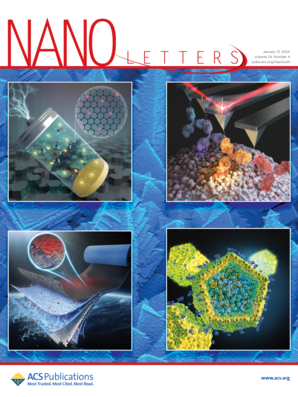硬碳中的闭孔结构和钠簇沉积可视化
IF 9.6
1区 材料科学
Q1 CHEMISTRY, MULTIDISCIPLINARY
引用次数: 0
摘要
要充分发挥硬碳(HC)储钠的潜力,需要对其复杂的多孔结构和电荷存储机制有深入的了解。虽然人们认识到HC孔内钠沉积对总容量的贡献,但对这一过程的详细可视化和机制理解仍然具有挑战性。本研究利用先进的电子显微镜技术来探测HC复杂的孔隙结构,并直接可视化其孔隙内的钠储存。采用具有丰富封闭孔隙的HC材料(PHC-1)作为平台材料,利用电子断层扫描技术重建PHC-1的孔隙结构,定量了解孔隙度、孔径和孔隙结构。低剂量电子显微镜显示亚稳钠团簇在钠化过程中填充在孔隙内。互补的原位和非原位表征进一步阐明了PHC-1的协同吸附-插层-填充机制。这一贡献为HC的结构-性质相关性提供了重要的见解。本文章由计算机程序翻译,如有差异,请以英文原文为准。

Closed Pore Architecture and Sodium Cluster Deposit Visualization in Hard Carbon
Achieving the full potential of hard carbon (HC) for sodium storage requires a deep understanding of its complex porous structure as well as charge storage mechanism. While the contribution of sodium deposition within HC pores to the overall capacity is recognized, detailed visualization and mechanistic understanding of this process remain challenging. This study leverages advanced electron microscopy techniques to probe the intricate pore architecture of HC and directly visualize sodium storage within its pores. By employing an HC material (PHC-1) with rich closed pores as the platform material, electron tomography is utilized to reconstruct the pore architecture of PHC-1, providing quantitative insights into porosity, pore size, and pore structure. Low-dose electron microscopy visualizes metastable sodium clusters filling up within the pores during sodiation. Complementary in-situ and ex-situ characterizations further elucidate the synergistic adsorption-intercalation-filling mechanism of PHC-1. This contribution provides significant insights into the structure–property correlation of HC.
求助全文
通过发布文献求助,成功后即可免费获取论文全文。
去求助
来源期刊

Nano Letters
工程技术-材料科学:综合
CiteScore
16.80
自引率
2.80%
发文量
1182
审稿时长
1.4 months
期刊介绍:
Nano Letters serves as a dynamic platform for promptly disseminating original results in fundamental, applied, and emerging research across all facets of nanoscience and nanotechnology. A pivotal criterion for inclusion within Nano Letters is the convergence of at least two different areas or disciplines, ensuring a rich interdisciplinary scope. The journal is dedicated to fostering exploration in diverse areas, including:
- Experimental and theoretical findings on physical, chemical, and biological phenomena at the nanoscale
- Synthesis, characterization, and processing of organic, inorganic, polymer, and hybrid nanomaterials through physical, chemical, and biological methodologies
- Modeling and simulation of synthetic, assembly, and interaction processes
- Realization of integrated nanostructures and nano-engineered devices exhibiting advanced performance
- Applications of nanoscale materials in living and environmental systems
Nano Letters is committed to advancing and showcasing groundbreaking research that intersects various domains, fostering innovation and collaboration in the ever-evolving field of nanoscience and nanotechnology.
 求助内容:
求助内容: 应助结果提醒方式:
应助结果提醒方式:


